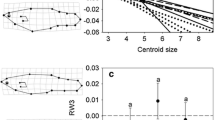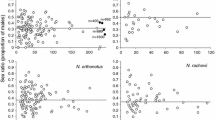Abstract
Based on demographic analysis of four different temporally enclosed demes of Pandalus borealis in Gullmarsfjorden on the Swedish west coast and published information, I discuss the notion of environmental sex determination in protandric pandalid shrimps as suggested by sex allocation theory. Demographic results showed that age structure and mortality rates varied substantially between four studied periods without noticeable effects on the age of sex change in the fjord populations. The majority of shrimps changed sex at an approximate age of 3 years and became females at an age of 3 to 4 years, however, low proportions (4 to 7%) of 2nd year females (transitional at ca. 1 year) and 3rd year females (5 to 12%) (transitional at ca. 2 years) were present each year. Low proportions of primary females were also found in two of the temporally enclosed demes, in 1985 (9%) and in 1987 (5%). These results do not indicate that yearly variations in age structure, mortality, or frequency of older breeders in the breeding population affect the age of sex change in temporally enclosed fjord demes of this protandric species. An alternative to assuming that the protandric mode of reproduction in pandalid shrimp is combined with environmental sex determination is suggested.
Similar content being viewed by others
Author information
Authors and Affiliations
Additional information
Received: 24 September 1996 / Accepted: 6 November 1996
Rights and permissions
About this article
Cite this article
Bergström, B. Do protandric pandalid shrimp have environmental sex determination?. Marine Biology 128, 397–407 (1997). https://doi.org/10.1007/s002270050105
Issue Date:
DOI: https://doi.org/10.1007/s002270050105




